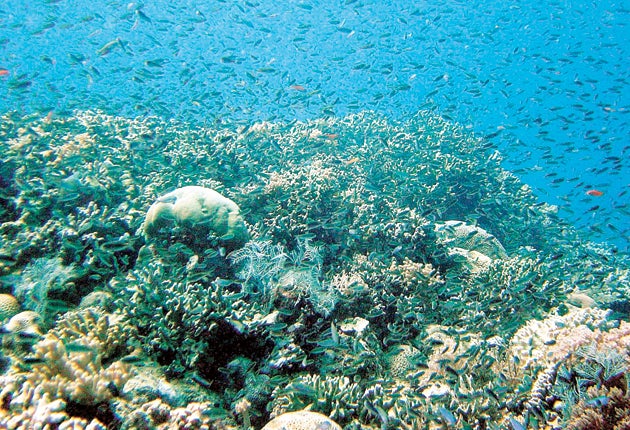Floodwater threatens overwhelming damage to Great Barrier Reef
The great deluge is pumping contaminated water into the ocean, with potentially disastrous results

Your support helps us to tell the story
From reproductive rights to climate change to Big Tech, The Independent is on the ground when the story is developing. Whether it's investigating the financials of Elon Musk's pro-Trump PAC or producing our latest documentary, 'The A Word', which shines a light on the American women fighting for reproductive rights, we know how important it is to parse out the facts from the messaging.
At such a critical moment in US history, we need reporters on the ground. Your donation allows us to keep sending journalists to speak to both sides of the story.
The Independent is trusted by Americans across the entire political spectrum. And unlike many other quality news outlets, we choose not to lock Americans out of our reporting and analysis with paywalls. We believe quality journalism should be available to everyone, paid for by those who can afford it.
Your support makes all the difference.Australia's great Barrier Reef, one of the ecological wonders of the world, may also be severely affected by the Queensland floods.
The pristine waters of the vast 1,400-mile reef system, home to thousands of exotic and often endangered marine species, from whales and dolphins, seabirds and tropical fish to tiny coral polyps, are threatened by huge volumes of polluted floodwater flowing out from the coast.
Already the brown flood "plume" has been detected offshore over a huge expanse of sea, stretching more than 1,000 miles from Cooktown in northern Queensland to Grafton, south of Brisbane in northern New South Wales. But it is in the centre of this area – the Barrier Reef's southern sector – that the threat is greatest.
Here, three big rivers are pouring their swollen and filthy waters out constantly – from north to south the Burdekin, which flows into the sea at Upstart Bay south of Townsville, the Fitzroy which enters the sea at Keppel Bay near Rockhampton, and the Burnett River, which empties into the Pacific at Burnett Heads near Bundaberg.
In all of these, top soil, sediment, rubbish, pesticides and fertilisers from farmland are being washed through the river systems out to sea, as well, potentially, as trace metals from flooded mines. All of these contaminants will be dumped on the reef and affect its salinity and water quality, besides directly threatening much of the fragile life in what is the world's largest living organism and the only one which can be seen from space.
The sediment in particular can silt up the coral reefs, the foundation for the whole ecosystem, and other habitats such as the extensive sea grass beds, which are used for grazing by those exotic sea mammals, dugongs. And there can be other, stranger impacts.
In the past, large floods of the Burdekin River have led to outbreaks of coral-eating crown-of-thorns starfish, and there is concern that a new wave could soon form on the reef.
"The timing and location of the three observed outbreaks of crown-of-thorns starfish in the past have all coincided with the times and place where the largest Burdekin floods have impinged on the reef," said Dr Katharina Fabricius, principal research scientist at the Australian Institute of Marine Science. "These outbreaks are still the greatest source of coral mortality on the Great Barrier Reef."
Off the Fitzroy River delta, where hydrologists estimate that the equivalent of three Sydney Harbours of floodwater is flowing out to sea through nearby Rockhampton and into the Great Barrier Reef lagoon every day, the Keppel Island group is in the firing line. Floods in 1991 wiped out vast swathes of coral in the islands.
Laureth Craggs, who runs the tourist resort of Pumpkin Island, said that water visibility was already down to one metre. "It is normally 25-30m under water, but the usually crystal-clear turquoise water is a murky mud brown," she said. "You can't see a thing."
Ms Craggs, who owns the five-cottage eco-island with her partner Wayne Rumble, said: "It is frightening to think that if 90 per cent of the coral dies, then all the sea life and tropical fish will also die with it or disappear."
"These are extraordinary events," said Jon Brodie, principle researcher for the James Cook University's Australian Centre for Tropical Freshwater Research. "The whole of the inner-shore reef lagoon is filled with river water."
Mr Brodie describes the threat to many coral reefs closest to the flooding rivers as "quite high" but expects the flood waters to affect in some way the reefs stretching from Frazer Island, 125 miles north of Brisbane, all the way to Cairns, 930 miles further north, as the prevailing tides and south-easterly winds mean the flood waters will probably continue to head in a northerly direction.
"It's quite remarkable to see," he said. "If you were to snorkel where the flood water meets the seawater and look to one side, the sea water will be clear with visibility to 50 metres, while the other side is fresh, dirty brown water where visibility is down to a metre."
The mix of nutrients, sediment and pesticides from agricultural run-off, plus unknown amounts of trace metals from flooded mines, will be likely to have an immediately devastating impact on corals and sea grasses, Mr Brodie said, with salinity possibly dropping to 10 parts per thousand or less, and remaining like that for weeks. "Nothing can live in those conditions," he said.
The reef is one of the world's most biodiverse, or species-rich, habitats in the world. Besides its 1,500 species of tropical fish, 30 species of whales, dolphins and porpoises have been recorded in its waters, along with six out of the seven sea turtle species, 15 species of seagrass, 215 species of birds and 17 species of sea snake.
Join our commenting forum
Join thought-provoking conversations, follow other Independent readers and see their replies
Comments